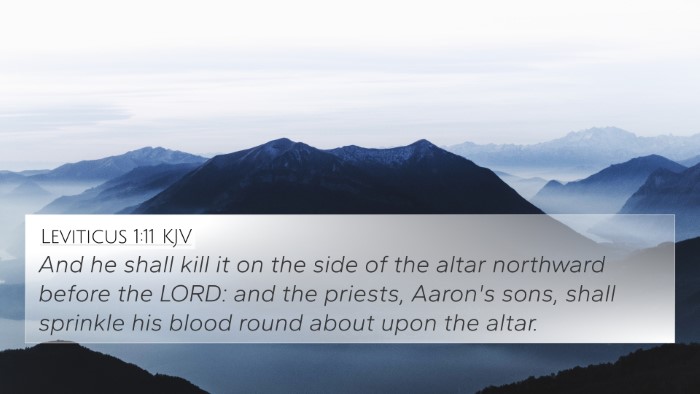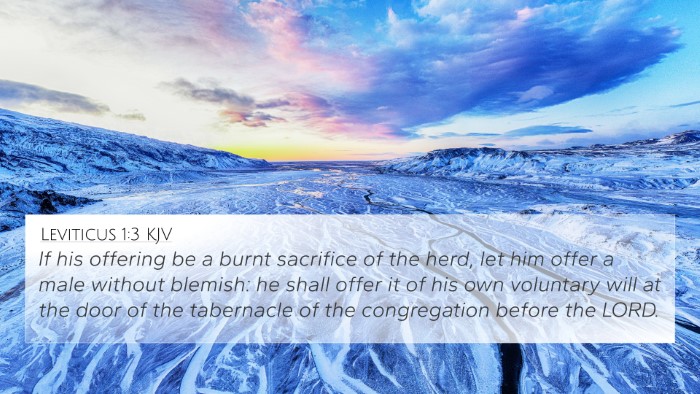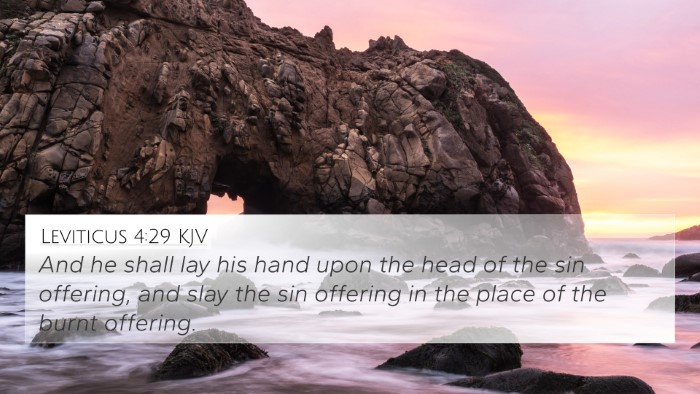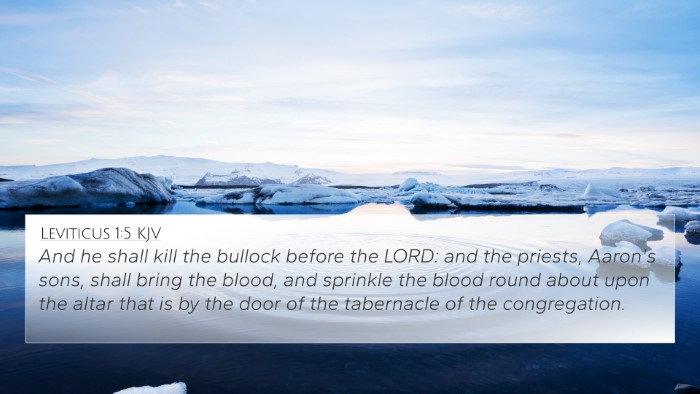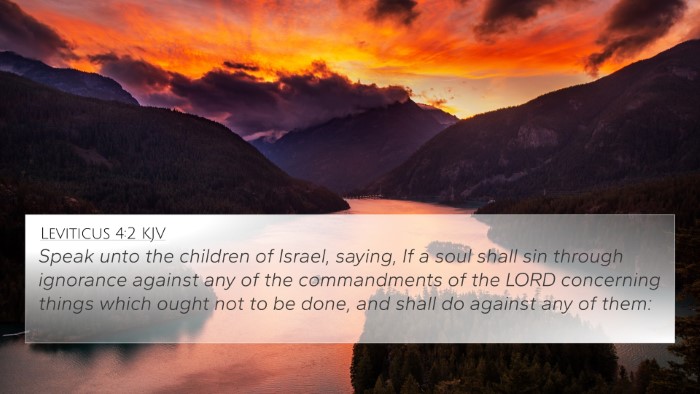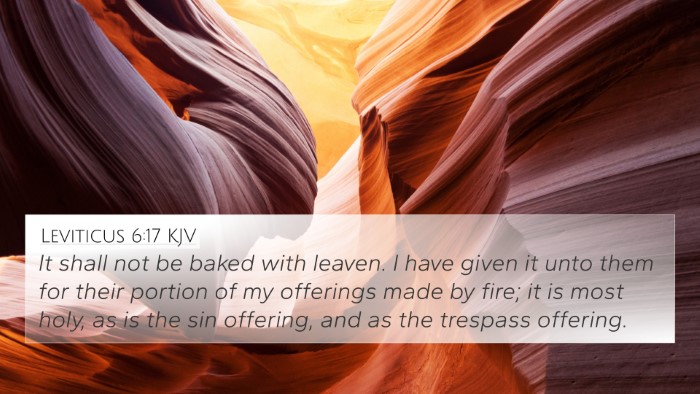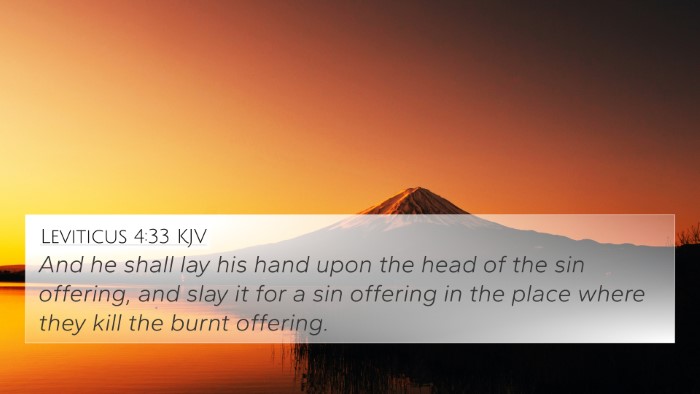Understanding Leviticus 6:25
Leviticus 6:25 states: "Say to Aaron and his sons, 'These are the regulations for the sin offering: The sin offering is to be slaughtered in the place where the burnt offering is slaughtered and its blood is to be splashed against the sides of the altar.'
This verse emphasizes the sacrificial system established by God for the atonement of sin. Here, we provide a comprehensive analysis from respected public domain commentaries.
Summary of Insights from Commentaries
-
Matthew Henry's Commentary:
Henry emphasizes the seriousness of sin and the necessity of atonement through the sin offering. He notes that these regulations reinforce the idea that God's holiness requires a proper approach to worship and sacrifice. He further underscores that the sin offering's location signifies unity in worship and highlights the shared responsibility of the community in addressing sin.
-
Albert Barnes' Notes:
Barnes highlights the importance of the sin offering, mentioning that it serves as an essential means by which the transgressor can find forgiveness. He discusses how the blood symbolizes life and conveys the deep connection between sin, death, and the need for redemption, pointing out that the prescribed method of sacrifice reflects God's order and justice.
-
Adam Clarke's Commentary:
Clarke elucidates the aspects of the ritual, focusing on the detailed instructions given for the offering. He suggests that this reflects not only the Lord's requirements but also the seriousness of approaching God with unconfessed sin. He draws parallels to the worship in the New Testament, highlighting the continuity of the sacrificial themes throughout the Bible.
Significance of Sacrificial Rituals
The sacrificial system in Leviticus establishes foundational truths about sin, redemption, and the nature of God. Leviticus 6:25 represents a component of this larger system:
- Holiness of God: The meticulous guidelines highlight God's holiness and the need for purity in worship.
- Community Responsibility: The sin offerings apply to the whole community, stressing collective accountability.
- Symbolism of Blood: The blood's role points to the seriousness of sin and the subsequent need for atonement.
Bible Verse Cross-References
Leviticus 6:25 connects with several other scripture passages, facilitating a deeper understanding through the framework of cross-referencing:
- Hebrews 9:22: "Without the shedding of blood, there is no forgiveness." - This verse reinforces the significance of blood in atonement.
- Romans 6:23: "For the wages of sin is death." - Emphasizing the consequences of sin and reflecting on sacrifice necessity.
- Exodus 30:10: "Aaron shall make atonement on its horns once a year..." - Related practices indicating the continued need for atonement.
- 1 John 1:7: "The blood of Jesus, His Son, cleanses us from all sin." - The ultimate fulfillment of the sacrificial system.
- Isaiah 53:5: "But He was pierced through for our transgressions..." - A prophetic look towards the suffering servant providing atonement.
- Leviticus 16:16: "He shall make atonement for the holy place..." - Connecting the broader context of atonement practices.
- Matthew 5:23-24: "If you are presenting a gift at the altar..." - Teaching on reconciliation correlates with the themes of sacrifice.
Thematic Connections
Leviticus 6:25 and its interpretations uncover significant themes that resonate throughout Scripture:
-
Redemption:
The need for atonement is a recurring theme; the Old Testament sacrifices prefigure the ultimate sacrifice of Christ.
-
Sin and Accountability:
The communal aspects of sin addressed through sin offerings highlight the need for collective responsibility.
-
Divine Order:
God's prescribed rituals demonstrate His intention for structured worship and relationship with humanity.
Cross-Referencing Biblical Texts
Cross-referencing various biblical texts related to Leviticus 6:25 helps to deepen the understanding of its implications:
-
Exploring Old and New Testament Links:
Identifying connections between the Old Testament sacrificial practices and the New Testament's fulfillment in Christ—seeing how the atonement system propels the understanding of redemption.
-
Comparative Bible Verse Analysis:
Examining verses from different books—like comparing Hebrews with Leviticus—can elucidate the continuity and changes in God's plans for atonement.
Conclusion
Through careful examination of Leviticus 6:25 alongside commentaries and cross-references, the depth and implications of this scripture are brought to light. Understanding the sin offering's role informs both theological perspectives and practical applications for today's believers, emphasizing the need for atonement and the ongoing significance of sacrificial themes within the biblical narrative.




